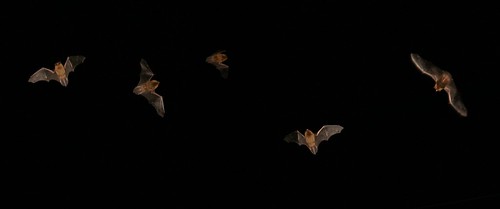What does “nietoperek” mean in Polish? Posted by Kasia on Mar 16, 2013 in Uncategorized
An extensive subterranean system of defenses (podziemny system obrony), often referred to as the Międzyrzecz fortifications (Ostwall), were built for German troops close to the previous German – Polish border from 1933 through to the end of the second world war in 1945. Today, sections of this underground bunker complex serve as perhaps the most important winter hibernation roost in Europe, for at least 12 species of bats.
During winter months large numbers of some of the rarest bat species (gatunki nietoperzy) converge in the passages of the Międzyrzeczki underground bunker system around the village of Nietoperek (nietoperz means bat in Polish) near Międzyrzecz. True bat numbers are almost impossible to ascertain because the entire system cannot be investigated thoroughly. Many of the tunnels are so full of water that entering them is virtually impossible. However, most researchers agree that the number of bats present here during the winter months number between 20,000 and 30,000. Many of these bats are rare or endangered species such as the barbastelles and mouse eared bat.
The bats travel from as far away as western Germany, the Czech republic and throughout Poland to this unique hibernation roost in October each year. The area around Międzyrzecz itself is home to only a small all year round bat population, the biggest of these is a colony of mouse-eared bats, which breed in and around the village of Nietoperek.
Some of the Europe’s rarest bat species, including; the Greater Mouse-eared bat (Myotis myotis), Barbastelle bat (Barbastella barbastellus), Bechstein’s bat (Myotis bechsteini), Whiskered bat (Myotis mystacinus), Natterer’s bat (Myotis nattereri), Daubenton’s bat (Myotis daubentonii), brown long-eared bat (Plecotus auritus), Northern bat (Eptesicus nilsonii), Brandt’s bat (Myotis brandtii), Pond bat (Myotis dasycneme), and the Serotine bat (Eptesicus serotinus) have been found roosting in the Nietoperek bat reserve in Lubuskie, western Poland.
The underground tunnel system is in many ways an ideal place for bats to hibernate, not least because the temperature in these corridors is a constant +10c. If during a bat’s winter hibernation its temperature drops below zero the bats will freeze to death or die of starvation. If it is too warm, bats will starve to death due to the rise in the metabolic rate causing the burn-up of their fat reserves. Unfortunately, the future of this valuable bat roost is by no means certain due to unthinking tourists and locals.
Do następnego razu… (Till next time…)

Build vocabulary, practice pronunciation, and more with Transparent Language Online. Available anytime, anywhere, on any device.
About the Author: Kasia
My name is Kasia Scontsas. I grew near Lublin, Poland and moved to Warsaw to study International Business. I have passion for languages: any languages! Currently I live in New Hampshire. I enjoy skiing, kayaking, biking and paddle boarding. My husband speaks a little Polish, but our daughters are fluent in it! I wanted to make sure that they can communicate with their Polish relatives in our native language. Teaching them Polish since they were born was the best thing I could have given them! I have been writing about learning Polish language and culture for Transparent Language’s Polish Blog since 2010.





Comments:
Jamaal Mcnamer:
Good article, thanks.